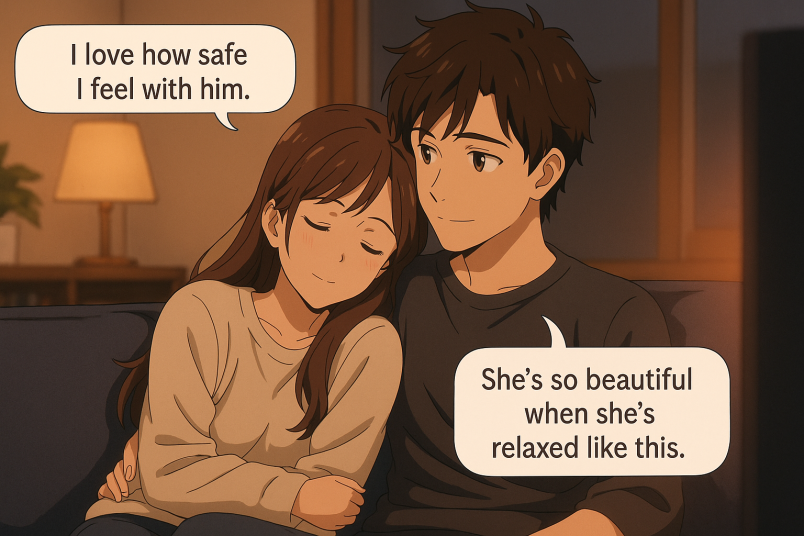7 Ways Love and Lust Are Related in a Relationship

Unlock Daily 30-Sec Tips for a Happier Relationship
👉 Subscribe FREEKey Takeaways
Marriage.com AI Quick Summary
Love and lust are two feelings that often blur into each other, yet feel so different when you experience them. One feels soft and safe, the other wild and consuming. Together, they can make your heart race and your soul feel deeply connected.
Sometimes, though, we wonder… is lust bad in a relationship, or is it simply another way our emotions speak?
The truth is, both love and lust can coexist beautifully when understood with care. They feed off one another, creating a rhythm that keeps passion alive while nurturing closeness.
When love gives meaning to desire and desire adds spark to love, something magical happens; it’s not just attraction or affection, it’s a dance of emotion and connection that keeps growing.
What is lust in a relationship?
Lust in a relationship is that spark of physical attraction that makes your heart race and your body respond almost instantly. It’s that “can’t keep my hands off you” feeling, the rush that pulls two people closer before words even matter.
It is like adding a touch of spice to your favorite dish – it can intensify the flavor or overpower it completely.
According to a study, lust contributes distinctly to female and male sexuality, and electric chemistry draws you irresistibly close to your partner.
Lust can feel powerful, intoxicating, and exciting—it’s the chemistry that often brings people together in the first place!
So, is lust needed in a relationship?
It can certainly add excitement, but learning to control lust is vital to maintaining a balanced and meaningful connection.
How important is lust in a relationship?
Ah, the million-dollar question! Lust in a relationship can be like a double-edged sword. It adds that tantalizing spark, igniting fiery passion between partners. Signs of lust in a relationship are hard to miss—the electric chemistry, the all-consuming desire, and the intense physical connection.
But here’s the thing… while lust can be exhilarating, it’s not the only ingredient for a lasting bond. It’s beautiful when it blends with love, care, and trust.
The key is learning how to nurture that physical spark without letting it overpower emotional intimacy. Finding that sweet balance is what keeps a relationship both passionate and meaningful.
What are the benefits of lust in a relationship?
Lust in a relationship can set the mood on fire, rekindling that passionate connection between partners. Signs of lust in a relationship include that magnetic pull and the toe-curling chemistry that keeps the butterflies fluttering. While love forms the bedrock, a sprinkle of lust can keep the flames alive.
When it’s shared with genuine love and respect, lust becomes a beautiful reminder of physical closeness and desire. It adds excitement, playfulness, and warmth—helping couples stay emotionally and physically connected over time. When balanced well, it’s not a distraction; it’s a spark that keeps love feeling alive.
7 ways love and lust are related in a relationship
Love and lust often walk hand in hand, creating a mix of emotions that can feel both exciting and deeply comforting.
One speaks to the heart, the other to desire, but together, they shape how two people connect, grow, and stay close. Let’s explore how these powerful forces beautifully intertwine within a relationship.
1. A passionate tango
Lust often takes the lead when two people first connect—it’s that irresistible pull, the spark that draws you closer and makes every glance or touch feel electric.
Love, on the other hand, steps in to give that passion meaning and depth. Together, they create a beautiful rhythm where desire fuels affection, and affection strengthens desire.
Here are some things to keep in mind:
- Let passion unfold naturally; don’t force it.
- Express affection through both words and touch.
- Focus on emotional connection, not just physical attraction.
2. The power of intimacy
Lust in a relationship can heighten intimacy, allowing you to explore your desires and vulnerabilities with your partner. The emotional connection of love makes this exploration even more profound, fostering trust and openness.
A study of 134 participants found that emotional intimacy indirectly increases partnered sexual activity through its effect on sexual desire. While men reported higher overall desire than women, both genders showed similar patterns—greater intimacy led to stronger desire, which then increased sexual interaction in long-term relationships.
When both partners feel safe and desired, physical closeness becomes more than passion; it becomes a form of communication. It’s how love speaks through touch, comfort, and shared understanding.
Here are some things to keep in mind:
- Create a space where both of you feel emotionally safe.
- Talk about what makes each of you feel loved and desired.
- Let vulnerability bring you closer instead of causing fear.
3. Fueling the fire
Lust can reignite the passion in a long-term relationship, adding zest to your love story. It’s that spice that keeps things exciting as long as it’s balanced with the foundation of love and emotional bonding.
A spark of desire can breathe new life into familiar routines, reminding partners why they were drawn to each other in the first place. When love and lust feed each other, the relationship continues to feel fresh and alive.
Here are some things to keep in mind:
- Surprise each other with small, romantic gestures.
- Revisit shared experiences that once made your bond special.
- Keep communicating about your evolving desires and needs.
4. Navigating the boundaries
While lusting after someone while in a relationship can be thrilling, it’s essential to discern the difference between love and lust. Love goes beyond physical attraction and encompasses emotional and mental connections, whereas lust focuses primarily on the physical.
Knowing where one ends and the other begins helps couples stay grounded. It keeps the bond meaningful, ensuring passion enhances the relationship instead of overshadowing it.
Here are some things to keep in mind:
- Recognize when attraction is purely physical.
- Nurture emotional closeness alongside desire.
- Talk openly about boundaries and expectations.
5. The yin and yang
Love and lust together create a harmonious balance. Love provides stability, trust, and emotional security, while lust adds that burst of adrenaline and passion. It’s like having a roller coaster ride that’s both thrilling and safe!
When both exist side by side, relationships flourish. They feel alive yet dependable, and this blend of warmth and excitement keeps two hearts beating in sync.
Here are some things to keep in mind:
- Appreciate the calm moments as much as the passionate ones.
- Balance physical attraction with emotional understanding.
- Celebrate both tenderness and excitement equally.
6. Knowing how to control lust
Managing lust in a relationship is crucial to maintaining a healthy connection. Communicate openly with your partner about your feelings and desires, ensuring you both are on the same page.
When you understand your emotions and respect your partner’s comfort levels, lust becomes a tool for closeness rather than conflict. It’s about enjoying passion without letting it steer the entire relationship.
Here are some things to keep in mind:
- Be mindful of your impulses and communicate them honestly.
- Focus on connection rather than constant stimulation.
- Remember that love grows when mutual respect guides desire.
7. The pleasure principle
Lust brings a rush of excitement that makes you feel alive, the quickened heartbeat, the warmth, the thrill of being completely drawn to your partner. It’s the spark that keeps desire vibrant and playful.
When love blends with this physical pleasure, it transforms passion into something deeper and more meaningful. The connection feels not just sensual, but soulful—a reminder that joy and affection can beautifully coexist.
Here are some things to keep in mind:
- Enjoy the physical connection without losing emotional depth.
- Be present in intimate moments instead of rushing them.
- Let love guide the way your passion unfolds.
How to deal with lust in a relationship
Lust can feel thrilling, can’t it?
That rush of desire, the spark that makes your heart race and your thoughts wander. But when it starts to cloud your emotions or create distance between you and your partner, it’s worth slowing down and reflecting.
Lust isn’t something to fear; it’s something to understand, to guide gently instead of suppressing. Here are a few ways to handle it with care:
- Acknowledge your feelings: Lust is natural, so don’t shame yourself for feeling it. Recognizing it honestly helps you stay mindful and grounded in your relationship.
- Talk openly with your partner: Share what you’re feeling, even if it’s uncomfortable. Open communication transforms tension into trust and brings a deeper emotional connection.
- Find balance between desire and affection: Physical attraction thrives best when mixed with love, care, and emotional closeness. Let passion strengthen your bond, not define it.
- Redirect your energy: When lust feels overwhelming, channel it into shared activities, laughter, or closeness. This keeps intimacy alive without letting impulse take over.
- Practice self-awareness: Notice when desire feels healthy versus distracting. Understanding your triggers helps you manage emotions before they start controlling your behavior.
In the end, lust can actually strengthen your relationship when guided by love and respect. It’s not about fighting the feeling but embracing it wisely, with warmth, understanding, and emotional clarity.
Watch this TED Talk by psychotherapist Esther Perel as she reveals how lasting desire thrives on both comfort and mystery, uncovering the secret to true erotic intelligence:
FAQs
Curious about how love and lust truly work together in relationships? You’re not alone! This section answers some of the most common questions about passion, attraction, and emotional connection, helping you understand how both can beautifully coexist.
-
Can a relationship survive without lust?
Yes, a relationship can survive without lust. While lust adds excitement, emotional connection, and love are the pillars of enduring partnerships. Intimacy, trust, and genuine affection can thrive without intense physical desires.
Couples can still find deep satisfaction and fulfillment through emotional bonds and shared experiences, building a strong and lasting connection.
-
Is love stronger than lust?
Obviously, love is stronger than lust. Love encompasses emotional intimacy, trust, and a profound connection that extends beyond physical attraction. Lust, while intense, is primarily driven by physical desire.
Love provides a solid foundation for a lasting relationship, nurturing the bond through life’s ups and downs. It fosters understanding, compassion, and a deeper sense of commitment, making it a more powerful force that sustains and enriches relationships in the long run.
-
Can lust fade over time?
Yes, lust can fade over time. Initially, the intense physical attraction might diminish as couples grow closer emotionally. As relationships evolve, the focus may shift from the physical to a deeper emotional connection.
However, the relationship still has its spark. It’s a natural progression, and as long as love, trust, and emotional intimacy thrive, the partnership can continue to be fulfilling and passionate in different ways.
-
How can couples maintain lust in a long-term relationship?
To maintain lust in a long-term relationship, couples should prioritize open communication about their desires and fantasies. They can keep the flame alive by exploring new experiences together, surprising each other with affectionate gestures, and prioritizing intimacy and quality time.
Physical touch, compliments, and showing appreciation for one another help reignite the spark. Embracing spontaneity and keeping the emotional connection strong will ensure that lust continues to thrive alongside their enduring love.
-
What comes first, lust or love?
There’s no fixed order; it varies for each couple. Sometimes, lust can ignite the initial attraction, drawing people together. Other times, a strong emotional connection forms the foundation, leading to love.
Both emotions can coexist and develop simultaneously. Lust may catch fire initially, but love often takes center stage as a relationship deepens. What truly matters is nurturing the emotional bond to build a lasting and fulfilling connection.
Finding harmony between heart and desire
Love and lust don’t have to compete; they can beautifully complete each other. Lust brings the spark, the thrill, the heartbeat that keeps things exciting. Love adds the calm, the care, the reason you stay even when the fire softens.
Together, they create a balance that feels both passionate and peaceful. It’s okay if one feels stronger at times… that’s just how relationships grow and shift.
What truly matters is nurturing both—with honesty, warmth, and effort. When love fuels desire and desire deepens love, the connection becomes something truly lasting and beautifully alive.
 Tips
Tips
Write your tip or submit a video tip
All tips are reviewed before the publishing.
Share this article on
Want to have a happier, healthier marriage?
If you feel disconnected or frustrated about the state of your marriage but want to avoid separation and/or divorce, the marriage.com course meant for married couples is an excellent resource to help you overcome the most challenging aspects of being married.
Recent Articles
Related Quizzes
Unlock Daily 30-Sec Tips for a Happier, Healthier Relationship
👉 Subscribe FREE on YouTube We'd love your feedback!
We'd love your feedback!
 Expert Q&A
Expert Q&A
Ask your question related to this topic & get the support you deserve from experts.



















 Thanks for your feedback!
Thanks for your feedback!